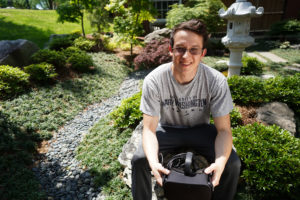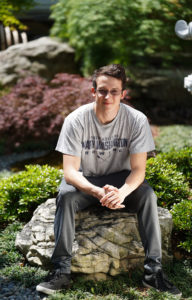On the rust-colored Rappahannock River four days a week, each pull must be perfect, said UMW men’s rowing team captain Corey Staier. The height of his hand. The length of the stroke through the still morning water. Every muscle engages. It’s about power, focus and timing.

Staier is just as intense on campus, where he casts his net wide. With a major in computer science, a minor in digital studies, and plenty of time studying psychology, physics and contemplative studies, he’s made the most of Mary Washington’s liberal arts education. Tomorrow, he’ll walk off the Ball Circle stage with a whopping 160 college credits and a ticket to sunny L.A. for a master’s program at the University of Southern California (USC). It’s among the country’s best for game design, which is what Staier plans to pursue. But the spectrum of knowledge he’s gained at UMW, he said, makes the possibilities endless.
“My interests are pretty diverse, but I’m confident that some fusion of bits of what I know from a liberal arts education, combined with master’s knowledge, will lend itself to just making things that make lives better,” said Staier, a new England native who grew up in Springfield, Virginia.
An elementary school robotics lab and MIT tour got him charged for technology. By the time he finished high school, he’d spent two months building games at Carnegie Mellon. Along the way, he taught himself programming, web development and code, thanks to a cousin who studied at UMW and recommended it.
At Mary Washington, Staier started out strong with the First Year Experience. Living on fifth floor Bushnell with like-minded students who also were taking a game-design seminar was “a beautiful experience,” he said. He loaded up on computer science classes and built an iPhone app for tour-takers. But game design wraps a complex web of expertise around a tech-savvy base, so he fanned out from there.
“Computer science grants us the ability to build anything we can imagine,” Staier said. “Digital studies adds a creative lens.” But he needed more. So he grabbed 18 credits of physics for physical perspective and 12 credits of psychology for a glimpse inside the human brain.
“Contemplative studies was for myself,” he said. “With fields so diverse, contemplation and being present resides in all of them equally.”

An Intro to Meditation class was a game-changer for Staier, who meditates daily for at least 20 minutes and completed an independent study called “Meditation in Virtual Reality.” Placing users on a virtual island, he measured brain activity and heartrate to monitor levels of calm with varying lights and colors of sunset.
“Through contemplative analysis, Corey applies quantum theory beyond the abstractly theoretical,” Hirshberg said. “Not many people in the world are pursuing such a track, but Corey did here at UMW.”
At Mary Washington, he also interned at IBM and MicroPact, studied abroad, designing games in Sweden and Wales, and took courses in piano, Italian, audio recording, GIS and more.
Across the country, at USC’s Viterbi School of Engineering, he’ll delve deeper into his passion for game design … and all his options.
“No path forward is going to be found in one discipline. I’m exploring everything that will make me a better person and make me better at what I do,” he said. “Everyone seeks to learn from or enlighten the world around them with whatever they’ve got talent and drive for. For me, that was this blend.”